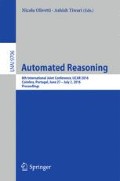Abstract
GAPT (General Architecture for Proof Theory) is a proof theory framework containing data structures, algorithms, parsers and other components common in proof theory and automated deduction. In contrast to automated and interactive theorem provers whose focus is the construction of proofs, GAPT concentrates on the transformation and further processing of proofs. In this paper, we describe the current 2.0 release of GAPT.
Supported by the Vienna Science Fund (WWTF) project VRG12-04, the Austrian Science Fund (FWF) projects P25160 and W1255-N23, and the ERC Advanced Grant ProofCert.
Access this chapter
Tax calculation will be finalised at checkout
Purchases are for personal use only
Notes
- 1.
For a list of changes and new features in the 2.0 release specifically, please refer to the release notes: https://github.com/gapt/gapt/blob/master/RELEASE-NOTES.md.
- 2.
We use Sat4j as it is bundled with GAPT. To use another solver, it is enough to replace Sat4j with Glucose or MiniSAT in the source code.
- 3.
This example is included in the examples/scriptability directory in the binary distribution of GAPT.
References
Andrews, P.B.: Resolution in type theory. J. Symbolic Log. 36(3), 414–432 (1971). doi:10.2307/2269949
Baaz, M., Hetzl, S., Leitsch, A., Richter, C., Spohr, H.: CERES: an analysis of fürstenberg’s proof of the infinity of primes. Theoret. Comput. Sci. 403(2–3), 160–175 (2008)
Baaz, M., Leitsch, A.: Cut-elimination and redundancy-elimination by resolution. J. Symbolic Comput. 29(2), 149–176 (2000)
Boespflug, M., Carbonneaux, Q., Hermant, O.: The \(\lambda {\Pi }\)-calculus modulo as a universal proof language. In: Pichardie, D., Weber, T. (eds.) Proceedings of PxTP2012: Proof Exchange for Theorem Proving, pp. 28–43 (2012)
Dunchev, C., Leitsch, A., Libal, T., Riener, M., Rukhaia, M., Weller, D., Paleo, B.W.: PROOFTOOL: a GUI for the GAPT framework. In: Kaliszyk, C., Lüth, C. (eds.) Proceedings 10th International Workshop on User Interfaces for Theorem Provers (UITP) 2012, EPTCS, vol. 118, pp. 1–14 (2012)
Eberhard, S., Hetzl, S.: Inductive theorem proving based on tree grammars. Ann. Pure Appl. Log. 166(6), 665–700 (2015)
Hetzl, S.: Project presentation: algorithmic structuring and compression of proofs (ASCOP). In: Jeuring, J., Campbell, J.A., Carette, J., Dos Reis, G., Sojka, P., Wenzel, M., Sorge, V. (eds.) CICM 2012. LNCS, vol. 7362, pp. 438–442. Springer, Heidelberg (2012)
Hetzl, S., Leitsch, A., Reis, G., Tapolczai, J., Weller, D.: Introducing quantified cuts in logic with equality. In: Demri, S., Kapur, D., Weidenbach, C. (eds.) IJCAR 2014. LNCS, vol. 8562, pp. 240–254. Springer, Heidelberg (2014)
Hetzl, S., Leitsch, A., Reis, G., Weller, D.: Algorithmic introduction of quantified cuts. Theoret. Comput. Sci. 549, 1–16 (2014)
Hetzl, S., Leitsch, A., Weller, D.: CERES in higher-order logic. Ann. Pure Appl. Log. 162(12), 1001–1034 (2011)
Hetzl, S., Leitsch, A., Weller, D.: Towards algorithmic cut-introduction. In: Bjørner, N., Voronkov, A. (eds.) LPAR-18 2012. LNCS, vol. 7180, pp. 228–242. Springer, Heidelberg (2012)
Hetzl, S., Libal, T., Riener, M., Rukhaia, M.: Understanding resolution proofs through Herbrand’s theorem. In: Galmiche, D., Larchey-Wendling, D. (eds.) TABLEAUX 2013. LNCS, vol. 8123, pp. 157–171. Springer, Heidelberg (2013)
Hurd, J.: The OpenTheory standard theory library. In: Bobaru, M., Havelund, K., Holzmann, G.J., Joshi, R. (eds.) NFM 2011. LNCS, vol. 6617, pp. 177–191. Springer, Heidelberg (2011)
Libal, T., Riener, M., Rukhaia, M.: Advanced Proof Viewing in ProofTool. In: Benzmüller, C., Paleo, B.W. (eds.) Proceedings of the 11th Workshop on User Interfaces for Theorem Provers (UITP) 2014, EPTCS, vol. 167, pp. 35–47 (2014)
Miller, D.: A compact representation of proofs. Stud. Logica 46(4), 347–370 (1987)
Miller, D.: ProofCert: broad spectrum proof certificates. An ERC Advanced Grant funded for the five years 2012–2016. http://www.lix.polytechnique.fr/Labo/Dale.Miller/ProofCert.pdf
Reis, G.: Importing SMT and connection proofs as expansion trees. In: Kaliszyk, C., Paskevich, A. (eds.) Proceedings Fourth Workshop on Proof eXchange for Theorem Proving (PxTP), EPTCS, vol. 186, pp. 3–10 (2015)
Stasko, J., Zhang, E.: Focus+context display and navigation techniques for enhancing radial, space-filling hierarchy visualizations. In: IEEE Symposium on Information Visualization, 2000, InfoVis 2000, pp. 57–65 (2000)
Sutcliffe, G.: The TPTP world – infrastructure for automated reasoning. In: Clarke, E.M., Voronkov, A. (eds.) LPAR-16 2010. LNCS, vol. 6355, pp. 1–12. Springer, Heidelberg (2010)
Sutcliffe, G., Suttner, C.: The State of CASC. AI Commun. 19(1), 35–48 (2006)
Sutcliffe, G., Schulz, S., Claessen, K., Van Gelder, A.: Using the TPTP language for writing derivations and finite interpretations. In: Furbach, U., Shankar, N. (eds.) IJCAR 2006. LNCS (LNAI), vol. 4130, pp. 67–81. Springer, Heidelberg (2006)
Acknowledgements
The authors would like to thank the following students, researchers, and software developers for their contributions to the development of GAPT (in alphabetic order): Alexander Birch, Cvetan Dunchev, Alexander Leitsch, Tomer Libal, Bernhard Mallinger, Olivier Roland, Mikheil Rukhaia, Christoph Spörk, Janos Tapolczai, Daniel Weller, and Bruno Woltzenlogel Paleo.
Author information
Authors and Affiliations
Corresponding author
Editor information
Editors and Affiliations
Rights and permissions
Copyright information
© 2016 Springer International Publishing Switzerland
About this paper
Cite this paper
Ebner, G., Hetzl, S., Reis, G., Riener, M., Wolfsteiner, S., Zivota, S. (2016). System Description: GAPT 2.0. In: Olivetti, N., Tiwari, A. (eds) Automated Reasoning. IJCAR 2016. Lecture Notes in Computer Science(), vol 9706. Springer, Cham. https://doi.org/10.1007/978-3-319-40229-1_20
Download citation
DOI: https://doi.org/10.1007/978-3-319-40229-1_20
Published:
Publisher Name: Springer, Cham
Print ISBN: 978-3-319-40228-4
Online ISBN: 978-3-319-40229-1
eBook Packages: Computer ScienceComputer Science (R0)

